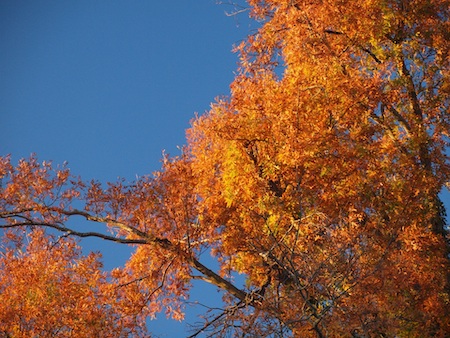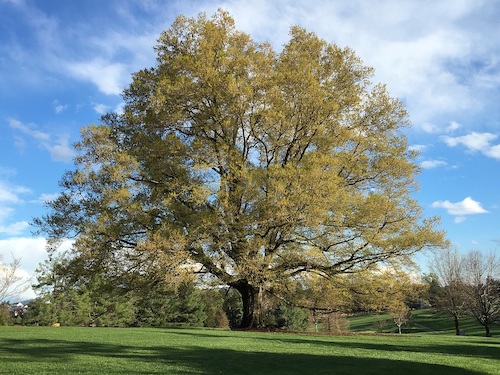 The leaves of Oak trees change colors from green to a variety of oranges, yellows, and browns in the Fall each year. Public domain photo on PixabayRoadways in a number of communities in Grant County are named after the Oak tree. Among the roadways are three separate Oak Streets in Bayard, Santa Clara, and Silver City. In addition, Oakridge Drive is located just east of Silver City, while Oakwood Avenue is situated just west of Silver City.
The leaves of Oak trees change colors from green to a variety of oranges, yellows, and browns in the Fall each year. Public domain photo on PixabayRoadways in a number of communities in Grant County are named after the Oak tree. Among the roadways are three separate Oak Streets in Bayard, Santa Clara, and Silver City. In addition, Oakridge Drive is located just east of Silver City, while Oakwood Avenue is situated just west of Silver City.
According to the United States Forest Service, oaks a common sight in the Cherry Creek Campground in the Gila National Forest: “In the autumn, hillsides turn into a beautiful mosaic of golden aspens, rusty oaks, and bright red sumac.”
The Oak tree is a symbol of importance to many in the United States and throughout the world.
In November of 2004, the United States Congress designated the Oak tree as the Official National Tree of the United States of America. The bipartisan legislative efforts were led by Congressman Bob Goodlatte of Virginia and Senator Ben Nelson of Nebraska.
 white oak tree candace freeland pixabay 2016The White Oak tree is the official state tree of Illinois and Maryland. (The photograph was provided courtesy of Ms. Candace Freeland through Pixabay, 2016.)
white oak tree candace freeland pixabay 2016The White Oak tree is the official state tree of Illinois and Maryland. (The photograph was provided courtesy of Ms. Candace Freeland through Pixabay, 2016.)
Six states have an Oak tree as their state tree symbol, including specific species in Georgia (Live Oak), Illinois (White Oak), Maryland (White Oak), and New Jersey (Red Oak). Also, the District of Columbia has the Oak (Scarlet) as its official tree symbol. Iowa recognizes the Oak tree as its state tree symbol.
The official state tree of Connecticut is actually a specific oak tree that no longer grows in the state.
The Charter Oak tree, according to the website of the State of Connecticut, got its name from the Charter issued to the Connecticut General Court by King Charles II of the United Kingdom in 1662. This charter established Connecticut as a colony of the United Kingdom.
When a subsequent leader of the United Kingdom – King James II – demanded the return of the charter, the document was hidden in the Charter Oak tree in 1687, according to the State of Connecticut. Not all historical accounts confirm that action, but the tradition is honored to this day as the state’s official tree.
While the Charter was not surrounded to the representative of the Crown on October 31, 1687, the Colony of Connecticut ceased to function as a distinct entity on that date, according to the History of New England, Volume III by Mr. John Gorham Palfrey in 1864. Connecticut became part of the Dominion of New England at that time, according to a quote in that book.
The tree itself had stood in what became Hartford for hundreds of years, according to Its destiny changed in 1856.
According to a news article dated September 20, 1856, in the Aurora of the Valley of Newbury, Vermont: “The old charter oak tree at Hartford, has been destroyed. The bells of the town were tolled, the papers went into mourning, and a dirge was performed over the prostrate trunk. Hartford had lost its most remarkable lion.”
This news article confirmed that the Charter Oak tree was destroyed in a major storm at about midnight on August 21, 1856. “Its base was 33 feet in circumference and it was broken off about eight feet from the ground,” the Aurora of the Valley stated.
 Germany, Ireland, Latvia, and Portugal are among the nations that have the Oak tree as their national trees. (The images were provided courtesy of Mr. Elias Schäfer through Pixabay.)
Germany, Ireland, Latvia, and Portugal are among the nations that have the Oak tree as their national trees. (The images were provided courtesy of Mr. Elias Schäfer through Pixabay.)
Beyond its status in the United States, the Oak tree is also recognized as the national tree of England, Germany, and Latvia. (Latvia also recognizes the Linden tree as one of its two national trees.)
Specific species of the Oak tree are recognized as the national trees of a number of countries around the world, including Cyprus (Golden Oak), Ireland (Sessile), Jordan (Mount Tabor), and Portugal (Cork Oak), among other nations. In other countries, the oak tree is considered the national tree, but not necessarily because of governmental decisions.
Part II will highlight additional information about Oak trees.
Do you have questions about communities in Grant County?
A street name? A building?
Your questions may be used in a future news column.
Contact Richard McDonough at chroniclesofgrantcounty@gmail.com.
© 2019 Richard McDonough


